Fracturing Fraktur
by Bob Brooke
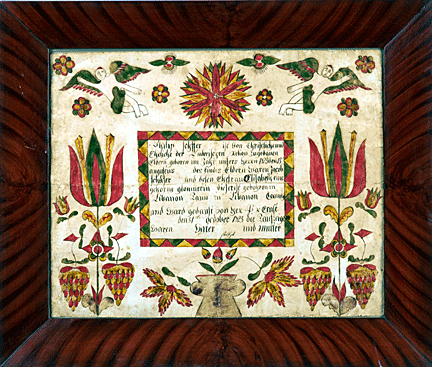 Fraktur
was a highly artistic and elaborate illuminated folk art that originated
in Germany in the 18th century. Named for the Fraktur script associated
with it, it reached its peak between 1740 and 1860. Fraktur
was a highly artistic and elaborate illuminated folk art that originated
in Germany in the 18th century. Named for the Fraktur script associated
with it, it reached its peak between 1740 and 1860.
What is Fraktur?
Laws in what’s now Germany dictated that all vital statistics on a
citizen be recorded, and the art of fraktur began as means by which
people could document and preserve important family information.
This form of folk illumination was already a well-established tradition
in Alsace and other parts of the Rhineland where it took the form of a
Taufschein, a short greeting in verse with illumination recalling the
baptism of a child and with only an oblique reference to time and place
of the baptism. Its chief purpose was not to record baptism but to
convey the wishes of the godparents who sponsored the child.
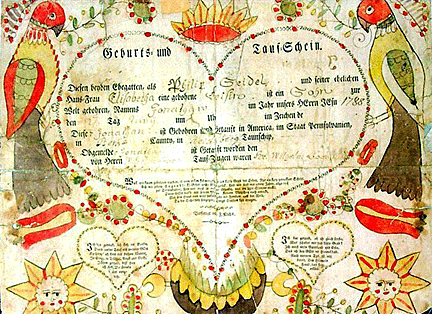 But
Taufschein created later in Pennsylvania had another purpose. It was a
formal record of birth as well as of the infant’s baptism. In a land
where there was as yet no bureau of vital statistics this certificate
became a legal document.. But
Taufschein created later in Pennsylvania had another purpose. It was a
formal record of birth as well as of the infant’s baptism. In a land
where there was as yet no bureau of vital statistics this certificate
became a legal document..
Fraktur styles were diverse and varied dramatically between artists.
Some fraktur were extravagant documents that draw attention to an
artist’s expert skill while others were simple drawings that contained
little
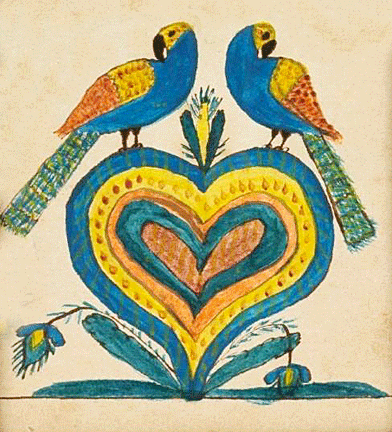 artistic
flair. Most fraktur often had religious themes, though some did have
secular ones. Men wrote most fraktur in German text, although they used
English text on all types of fraktur after the early 1820s. . artistic
flair. Most fraktur often had religious themes, though some did have
secular ones. Men wrote most fraktur in German text, although they used
English text on all types of fraktur after the early 1820s. .
While Pennsylvania Germans created most fraktur for record keeping, they
also made them just for fun. Some schoolmasters created drawings as
rewards of merit for their students. Others were simply decorative
pieces. Regardless of purpose, fraktur was a personal art that was
extremely popular with 19th century rural families of Pennsylvania.
Fraktur Origins
The first Fraktur typeface arose in the early 16th century, when Emperor
Maximilian I commissioned the design of the Triumphal Arch woodcut by
Albrecht Dürer and had a new typeface created specifically for this
purpose, designed by Hieronymus Andreae.

The name Fraktur came from the Latin fractus, meaning “broken.” It was a
blackletter typeface—a gebrochene Schrift in German, which meant “broken
font”—which the bends of the letters were angular or “broken,” as abrupt
changes in stroke direction occur.
Pennsylvania Germans and Fraktur
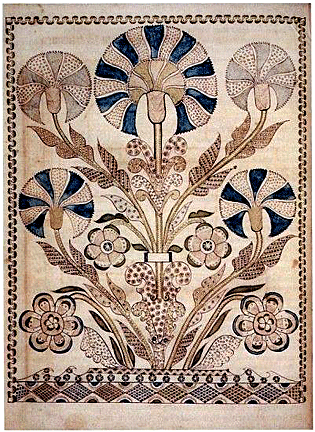 Although
its roots lie in medieval Europe, fraktur was an art form that came into
its own and flourished amid the Pennsylvania Germans, who brought it
with them to the New World. Although
its roots lie in medieval Europe, fraktur was an art form that came into
its own and flourished amid the Pennsylvania Germans, who brought it
with them to the New World.
German-speaking immigrants brought their knowledge of Fraktur lettering
to America. Members of the Ephrata Cloister—a religious community in
Lancaster County, Pennsylvania—produced some of the earliest American
fraktur during the 1740s using inks, paints, and paper produced at the
Cloister. Pennsylvania Germans made most fraktur between 1740 and 1850
in southeastern Pennsylvania, although many early German immigrants who
settled in New Jersey, Ohio, Virginia, Maryland, North Carolina and even
Canada made produced fraktur.
The Cloister’s brothers and sisters used fraktur letters to copy
scriptures and hymn books. Some of the earliest frakturs done there were
quite primitive. The written documents they created weren’t official in
nature, but rather represented attempts at basic recordkeeping
functions, such as birth and baptismal certificates, and marriage
records.
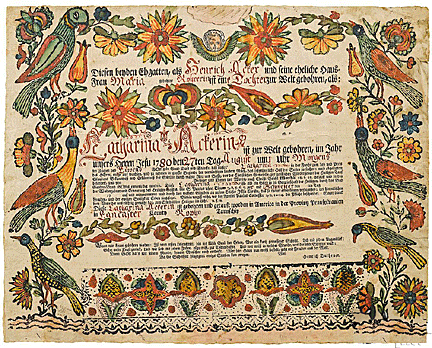 Pennsylvania
Germans made fraktur for a variety of reasons. The majority of fraktur
were birth and baptismal certificates, called Geburts-und Taufscheine.
Some of the many other types of fraktur include writing samples, rewards
of merit, house blessings, bookplates, hymnals, New Year’s greetings and
love letters. Pennsylvania
Germans made fraktur for a variety of reasons. The majority of fraktur
were birth and baptismal certificates, called Geburts-und Taufscheine.
Some of the many other types of fraktur include writing samples, rewards
of merit, house blessings, bookplates, hymnals, New Year’s greetings and
love letters.
In order to produce more fraktur in a shorter amount of time, the
members of the Ephrata Cloister in Ephrata, Pennsylvania, began using a
printing press in the 1780s to produce documents. Nearby cities of
Reading, Lancaster, Allentown, Harrisburg, and Hanover soon developed
important fraktur printing centers of their own.
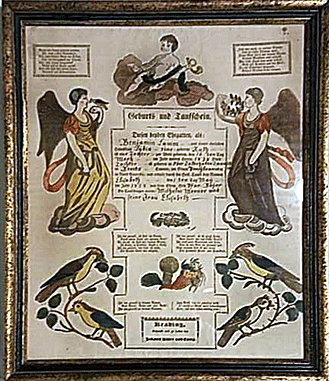 Many
professional fraktur artists used printed documents to keep up with
customer demand. Even so, those living in rural farming communities
continued to personalize each printed document. They filled-in
customers’ personal information and often handcolored or embellished
printed designs. Many
professional fraktur artists used printed documents to keep up with
customer demand. Even so, those living in rural farming communities
continued to personalize each printed document. They filled-in
customers’ personal information and often handcolored or embellished
printed designs.
Pennsylvania German fraktur contained elaborate lettering and colorful
drawings, along with intricate borders and scrollwork designs. Artists
employed hundreds of different motifs to decorate these documents. Their
drawings included vivid illustrations of people, buildings and animals,
as well as complicated geometric patterns. The most favored designs were
of angels, birds, hearts, and flowers. Some fraktur even depicted
mythical creatures such as unicorns or the legendary Wonderfish. The
American flag, the bald eagle and other political symbols of the newly
formed United States became popular motifs at the beginning of the 19th
century.
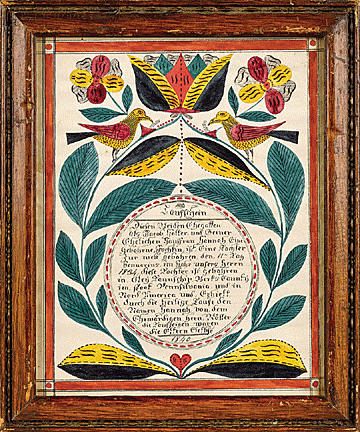 Prior
to 1820, most Pennsylvania Germans belonged to the Lutheran Church or
the German Reformed Church. Because of their larger population,
followers of the Lutheran Church and the German Reformed Church produced
most American fraktur, many of which were either Geburts or Taufscheine,
birth and baptismal certificates. Prior
to 1820, most Pennsylvania Germans belonged to the Lutheran Church or
the German Reformed Church. Because of their larger population,
followers of the Lutheran Church and the German Reformed Church produced
most American fraktur, many of which were either Geburts or Taufscheine,
birth and baptismal certificates.
Berks County, Pennsylvania, families preferred “personalized” forms, and
residents held onto the fraktur tradition longer than did neighboring
counties. Fraktur artists and itinerants crisscrossed the county
producing birth certificates which by that time now recorded the details
of births for vital statistic records. Reading printers created the
printed source these artists and scriveners needed to expedite
production.
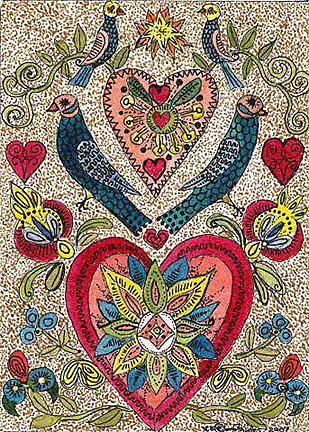 Pennsylvania
Germans usually made fraktur for personal use and put them in storage
for safekeeping. The personal and religious information recorded on
fraktur was of great importance to them. Only a few types of fraktur—such
as house blessings or valentines—would have been displayed in their
homes. More often, people rolled up fraktur documents and hid them away,
pasting them underneath the lids of storage chests or keeping them
neatly folded inside books and Bibles. Pennsylvania
Germans usually made fraktur for personal use and put them in storage
for safekeeping. The personal and religious information recorded on
fraktur was of great importance to them. Only a few types of fraktur—such
as house blessings or valentines—would have been displayed in their
homes. More often, people rolled up fraktur documents and hid them away,
pasting them underneath the lids of storage chests or keeping them
neatly folded inside books and Bibles.
Fraktur thrived in Pennsylvania German communities for more than a
century. By the 1850s, however, interest in fraktur began to decline.
Prior to the Civil War, the United States experienced a surge in
nationalist pride. With the encouragement of speaking only English,
traditional German-speaking parochial schools and their German
schoolmasters, who created many fraktur, soon faded into the past. And
baptism, a key force driving the mass-printing of fraktur birth and
baptismal certificates, lessened in importance in favor of confirmation.
Making Fraktur
Ministers and school teachers created most fraktur on paper for
individuals, although often more than one artist usually created them. A
scrivener, or professional penman, wrote out the text of the document in
the Fraktur scrips, then outlined drawings, and added scrollwork. A
decorator, who may or may not have been the same person, applied the
vibrant colors and motifs that decorated it.
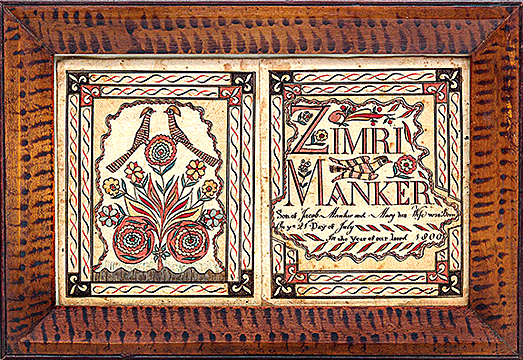
A variety of instruments filled the fraktur artist’s toolkit. Some of
the most important tools included quill pens, brushes, straight edges,
compasses, stencils, woodcut stamps, pencils and paper. Fraktur artists
used laid paper during the 1700s. Woven paper—which has a smoother
surface—became common after 1810. Decorators used imported
pigments—carmine, vermilion, umber, gamboge and indigo—to make their
colorful inks. They mixed these pigments with various binding substances
to create glossy or muted effects. Scriveners usually wrote with iron
gall ink—a standard writing ink blended from iron salts and vegetable
tannins. Unfortunately, iron gall ink was very acidic and caused many
fraktur to deteriorate.
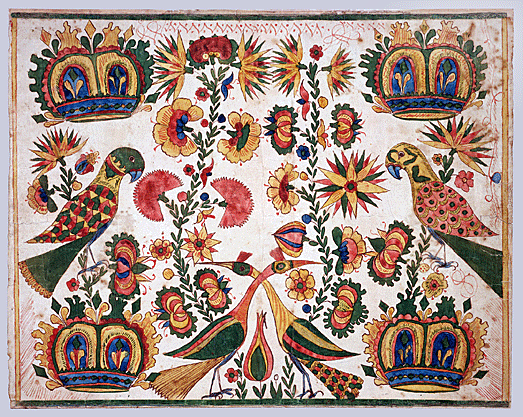
Originally, the inks used to draw fraktur would had been concocted of
natural ingredients such as berries, iron oxide and apple juice.
However, the acids found in these inks led to deterioration and
discoloration, or to brown stains left behind by the iron oxides.
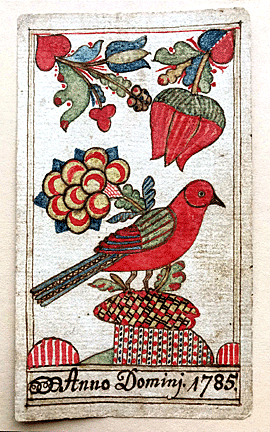 Perhaps
because of these concerns, the Ephrata Cloisters’ fraktur artisans
relied mainly on black inks and plainer styles of fraktur without the
illumination and decoration of others produced at that time. Perhaps
because of these concerns, the Ephrata Cloisters’ fraktur artisans
relied mainly on black inks and plainer styles of fraktur without the
illumination and decoration of others produced at that time.
Images of the bird or distelfink were common on Pennsylvania German
fraktur, and, as with most of the fraktur images, they had symbolic
importance. Parakeets typically represented the soul, as people viewed
the birds as liaisons between heaven and earth.
Many major American museums, including the American
Folk Art Museum, the Metropolitan Museum of Art, the Philadelphia Museum
of Art, and the Winterthur Museum have Fraktur in their collections.
Important Fraktur have been sold by major American auction houses and
antique dealers for prices in excess of $100,000.
<
Back to Readers Ask Archives
Next Article >
|
